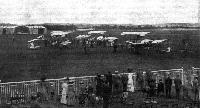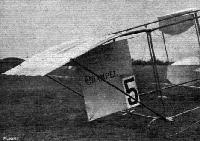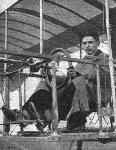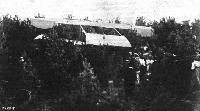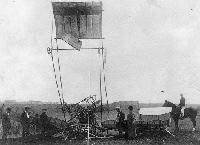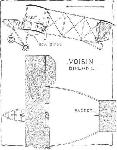L.Opdyke French Aeroplanes Before the Great War (Schiffer)
Deleted by request of (c)Schiffer Publishing
Voisin Type de Course. 1910: This entirely new design - and the smallest so far - was another effort to replace the standard model still in use throughout the world. It featured steel tube wing and outrigger beams. The design was gradually improved, appearing in races and airshows; one was flown by Bielovucic in his flight from Paris to Bordeaux. The new ones replaced the biplane tail cell with a single upper surface and a single rudder below it, which survived throughout WWI; and the drooping ailerons set peller speeds. Unlike the one-off Racing Biplane, the Type Bordeaux was in production.
(Span: 11 m; length: 10.5 m; wing area: 46 sqm; empty weight: 480 kg; 55 hp ENV)
Type Tourisme: Developed from the Type Bordeaux, this version was a little smaller than its parent and lacked the nosewheel. It featured a full dual control system.
(Span: 11 m; length: 9.5 m; wing area: 32 sqm; empty weight: 400 kg; 50 hp Gnome)
Type Militaire, 1910: Also developed from the Type Bordeaux, this one had folding outer wing panels and kept the nosewheel; it also had dual controls.
(Span: 11 to 16 m (unfolded); length;9.5 m; wing area: 42 sqm; speed: 87 kmh; 50 hp Gnome)
Показать полностью
Журнал Flight
Flight, April 16, 1910
NEW RACING VOISIN BIPLANE.
ON this page we reproduce a couple of photographs which convey a very good idea of the new Voisin machine which has just been built for Rougier, and on which he hopes to win some of the chief prizes at the various big meetings during the year. It will be noticed that one striking departure from the characteristic of the Voisin is in the tail, which is now similar to that adopted by Sommer and Farman. Side curtains between the main planes have also been dispensed with, and transverse stability is controlled by long biplane ailerons between the main planes. The arrangement of the prow and elevating plane has also undergone slight modification. The span of the main planes is 9 metres, and the total lifting surface of the machine 33 square metres, while the overall length is 9 metres. The weight, with fuel, &c, on board, is 350 kilogs. A single two-bladed Voisin propeller, of 2 metres diameter, is fitted, and driven at a speed of 1,200 revs, per min. by an 8-cylinder 50-h.p. water-cooled E.N.V. motor.
Flight, July 16, 1910
Flying from Denmark to Sweden.
ALTHOUGH there was a strong wind blowing, four aviators, endeavoured to fly across the Sound from Copenhagen to Malmoe, Sweden, on Wednesday of last week. Two of them turned back, as the wind proved to be too strong. Baron Cederstrom, on a Bleriot, and M. Svendson, on a Voisin, descended on the Isle of Saltholm, nearly half way across, as both were experiencing trouble with their engines. Later M. Svendson flew back to the Danish shore.
Flight, September 10, 1910
PARIS-BORDEAUX.
TRULY rapid fame, almost unequalled in the annals of the world, is being attained by means of aviation. Day by day some new flyer whose name has hardly appeared in print, becomes one of the leading lights of the universe by reason of some extraordinary feat, either novel in itself or surpassing previous exploits of a similar character. In this category must almost be included Bielovucie, for although he has been known in certain circles in the flying world, until the last few weeks his name was practically unknown to the general public. And yet, with little preliminary fuss last week, and mainly in order to avoid the very heavy expense entailed in transporting his Voisin machine to Bordeaux from Paris, where he proposes to fly at the big aviation meeting, he determined to take the air for the entire journey, merely descending for necessary replenishment stops and rest. Without a suspicion of Serious delay he has succeeded magnificently, and once more the tablets of history must receive an addition by the inscription of his name for this fine work. The total distance between the two points is 540 kiloms., and this Bielovucie covered in three successive days with three landings, in the total flying time of 6 hrs. 15 mins. The longest stage was between Orleans and Chatellerault, this totalling to 170 kiloms., the shortest being the first stage, starting from Issy, between Paris and Orleans, with 110 kiloms. The various stages, with times, are as follows :-
kiloms. Start. Arrival. Time, h. m.
Paris-Orleans 110 6.5 7.15 1 10
Orleans-Chatellerault 170 9.35 11.20 1 45
Chatellerault-Angouleme 135 3.30 5.15 1 45
Angouleme-Bordeaux 125 10.48 12.25 1 37
Total for the 540 kiloms. 6 15
In the first stage he travelled over Montrouge, D'Arpajon and Etampes, before alighting at Orleans. Rising from the military field of manoeuvres at Grouves before actually making a start for the second stage, Bielovucie made a trip round the plain four times in spite of a very bad fog prevailing at the time. Later, when the sun had dissipated the thick mist at 9.35, he rose from the ground for his second stage. During this journey the route took him over Blois and Tours, he passing over the latter town at three minutes past eleven, and at 11.20 he descended at Chatellerault for dejeuner. Restarting at 3.30, he was speeding over Poitiers at 3.45, Couhe-Verac at 4.10, and descended at Angouleme for the night at 5.15. The next morning the completion of the journey to Bordeaux was successfully accomplished with a start at 10.48, he was sighted over Libourne at 12 noon, where he had to rise to about 1,000 metres in consequence of some violent wind eddies met with. Bordeaux was reached at 12.25, although Bielovucie did not actually finish his journey at the Beau Desert Aerodrome until 10 minutes later, during which interval he passed over the Cathedral at a height of 1,600 ft., and the Grand Theatre, where the streets were positively black with the populace who had sallied forth en masse to welcome the popular aviator. And so, what will presently become hardly a matter for unusual comment, this further remarkable step in the history of aviation ended, with the material reward to the hero of a gold medal which is to be presented to him by the Bordeaux Departmental Assembly in recognition of the first man to fly from Paris to Bordeaux. As a preliminary to the Bordeaux aviation meeting, the promoters have assuredly reaped a magnificent advertisement for their project, which starts on Sunday next.
Flight, October 22, 1910
IMPRESSIONS OF THE PARIS SHOW.
By OISEAU.
<...>
The military value of aeroplanes as illustrated during the recent manoeuvres has induced many makers to design specially for the Army. Clerget, for instance, has produced a tandem monoplane with three seats and driven by a 200-h.p. motor. Voisin is the first to fit a mitrailleuse to his two-seater biplane. The effects produced after firing this gun from some height ought to be interesting. The Breguet biplane and the Hanriot and Bleriot monoplanes are also mounted as aeroplanes of war.
<...>
After many months of faithful adherence to the cumbersome but simple box-kite type of biplane, Messrs. Voisin have recently come into line with other makers, and with astonishingly successful results. The machine displayed by them on the stand of the Compagnie Aerienne is a two-seater copy of the Paris-Bordeaux type. The front elevator has gone, though the fusellage is still built out in the canoe-shaped manner of the earlier models, but without the former canvas covering. Gone, too, are the vertical planes and the box tail. Large ailerons are fitted to the trailing edge of the upper plane, and the present tail is one of the simplest on the market. The trailing edge of the tail plane (which is curved and weight carrying) is hinged and acts as an elevator, and the square rudder is immediately beneath. The two seats are placed side by side, the passenger sitting to the left. In front of him is placed, on this model, a mitrailleuse of similar calibre to those used in the French Army, but considerably lighter. Steel tubes have replaced the wooden portions of the framework.
<...>
Flight, December 10, 1910
AEROPLANE SILHOUETTES FROM THE PARIS SHOW.
THE VOISIN BIPLANE.
CONSTRUCTED in France by Voisin Freres (Charles and Gabriel Voisin). The first European biplane of real success. Elevator incorporated in tail. No forward elevator. Framework of steel tube. Fabric is Continental aeroplane material. A type with conventional wooden framework is still constructed. Holder of the world's biplane speed record made by Bunau-Varilla at Rheims (1910).
General Dimensions. - Length overall (steel type), 10.50 metres; (wooden type) 10.40 metres; width (steel type), 11 metres; (wooden type) 10 metres. Width of main planes (both types), 2 metres.
Seating capacity. - (Steel type) two seats placed side by side and with dual control; (wooden type) single seater, seats placed in front of main planes in both types.
Engine. - 60-h.p. 8-cyl. V-type water-cooled E.N.V., or 50-h.p. 7-cyl. rotary air-cooled Gnome, or according to choice.
Propeller. - Voisin two-bladed, of steel; variable pitch. Situated behind main planes.
Chassis. - Two wheels; no skids; small wheel placed forward about three feet from the ground to take initial shock of bad landing.
Tail. - Monoplane tail with elevator hinged to trailing edge. Single rudder placed centrally below tail plane.
Lateral stability. - By large ailerons fitted to the trailing edge of the upper main plane.
Weight. - Complete with motor (60-h.p. E.N.V.), 370 kilogs.
Speed. - 80 to 90 kiloms. an hour.
System of control. - By a wheel at the end of a horizontal shaft and moving in a sleeve; pulling the wheel elevates the machine, pushing depresses the elevator; rotating the wheel in either direction steers the aeroplane as an automobile. Two pedals in front of the pilot actuate the ailerons for the maintenance of lateral stability, the right pedal depressing the left aileron and vice versa.
Price. - (Steel type) with 60-h.p. E.N.V., 25,500 francs; with 50-h.p. Gnome, 28,000 francs.; without engine or propeller, 14,000 francs. (Wooden type) with 60-h.p. E.N.V., 23,500 francs; with 50-h.p. Gnome, 26,000; and with 55-h.p. Antoinette, 25,000 francs.
Показать полностью






